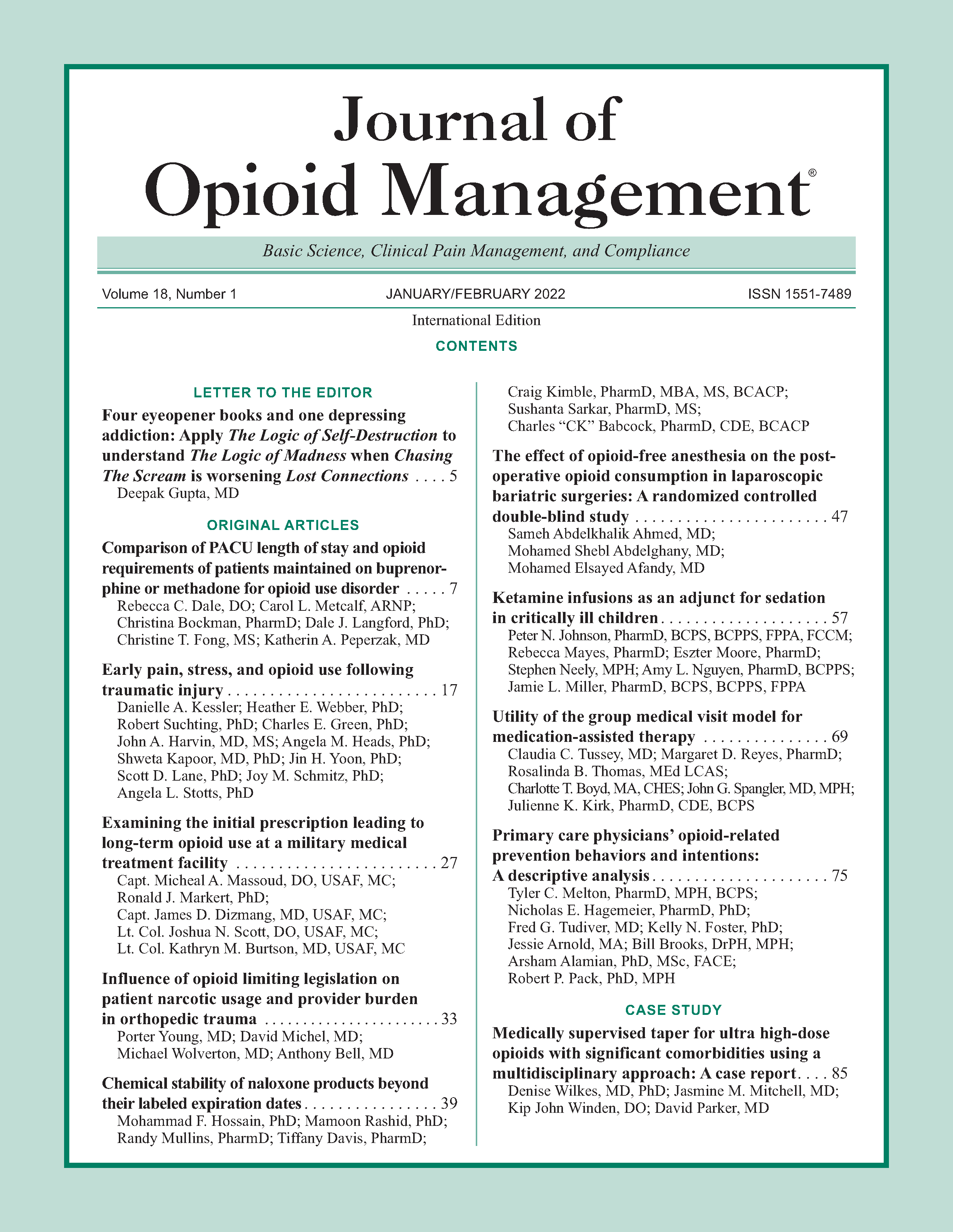Chemical stability of naloxone products beyond their labeled expiration dates
DOI:
https://doi.org/10.5055/jom.2022.0693Keywords:
naloxone, stability, potency, shelf-life extension, HPLCAbstract
Objective: The purpose of this study was to evaluate the chemical stability of previously dispensed, expired naloxone products.
Setting: When properly stored, certain products maintain stable, defined as within compendia acceptability, beyond their manufacturer's expiration date. Stockpiling life-saving medications such as the opioid overdose reversing agent naloxone nasal spray (NNS) or injection (NIJ) is of utmost importance to ensure public health emergency preparedness and response.
Design/interventions/methods: After each naloxone product was stored at room temperature for several months (6-19) past their labeled expiration date, the level of active therapeutic content and the presence of degradation impurity, 2,29-bisnaloxone, were evaluated via chromatographic separation with waters higher performance liquid chromatography integrated using the Waters X-Select CSHC-18. The effluent was detected at 229 nm.
Main outcome measure: Active naloxone presence and the presence of degradation impurity, 2,29-bisnaloxone, were evaluated.
Results: The mean potency of naloxone in both NNS and NIJ, up to 10 and 19 months post-expiration, respectively, is within the 90-110 percent United States Pharmacopeia acceptance limit (NNS: 102.8 ± 2.6 percent and NIJ: 106.0 ± 1.3 percent). No impurity was detected in any chromatogram of the expired products.
Conclusion: In summary, since both NNS and NIJ were found to be chemically stable beyond 10 months of the expiration date, shelf-life extension of climate controlled, commercially available naloxone products should be further investigated as a potential cost savings measure for national strategic stockpiles, emergency medical services, hospitals, and public responders.
References
Chen LH, Hedegaard H, Warner M: Drug-poisoning deaths involving opioid analgesics: United States, 1999-2011. In NCHS Data Brief. 2014: 1-8.
CDC: Opioid Overdose/Understanding the Epidemic. Atlanta: CDC, 2017.
White JM, Irvine RJ: Mechanisms of fatal opioid overdose. Addiction. 1999; 94(7): 961-972.
van der Schier R, Roozekrans M, van Velzen M, et al.: Opioid-induced respiratory depression: Reversal by non-opioid drugs. F1000Prime Rep. 2014; 6: 79.
Rolland B, Bouhassira D, Authier N, et al.: Misuse and dependence on prescription opioids: Prevention, identification and treatment. Rev Med Intern. 2017; 38: 539-546.
USP Monographs: Naloxone hydrochloride. Rockville, Maryland: United States Pharmacopeial Convention Inc., 2018.
Limited APO: Narcan nasal spray package insert. 2015. Available at https://www.accessdata.fda.gov/drugsatfda_docs/label/2015/208411lbl.pdf. Accessed September 15, 2020.
Website TG: How price-gouging of opioid overdose cure costs lives: There’s never enough. 2016. Available at https://www.theguardian.com/society/2016/dec/16/opioid-overdosenaloxone-pharmaceutical-price-gouging. Accessed September 15, 2020.
Gupta R, Shah ND, Ross JS: The rising price of naloxone—Risks to efforts to stem overdose deaths. N Engl J Med. 2016; 375(23): 2213-2215.
Beletsky L: The benefits and potential drawbacks in the approval of EVZIO for lay reversal of opioid overdose. Am J Prev Med. 2015; 48(3): 357-359.
Stat LFO: Kaleo, maker of $4,100 overdose antidote, authorizes a generic version for just $178. 2018. Available at https://www.statnews.com/2018/12/12/kaleo-evzio-overdose-antidotegeneric/. Accessed September 15, 2020.
Hawk KF, Vaca FE, D'Onofrio G: Reducing fatal opioid overdose: Prevention, treatment and harm reduction strategies. Yale J Biol Med. 2015; 88(3): 235-245.
Beletsky L, Rich JD, Walley AY: Prevention of fatal opioid overdose. JAMA. 2012; 308(18): 1863-1864.
Merlin M, Saybolt M, Kapitanyan R, et al.: Intranasal naloxone delivery is an alternative to intravenous naloxone for opioid overdoses. Am J Emerg Med. 2010; 28(3): 296-303.
Beletsky L, Rich JD, Walley AY. Prevention of fatal opioid overdose [published correction appears in JAMA. 2012; 308(24): 2565]. JAMA. 2012; 308(18): 1863-1864. DOI: 10.1001/jama.2012.14205.
Barton ED, Colwell CB, Wolfe T, et al.: Efficacy of intranasal naloxone as a needleless alternative for treatment of opioid overdose in the prehospital setting. J Emerg Med. 2005; 29(3): 265-271.
Edwards ET, Edwards ES, Davis E, et al.: Comparative usability study of a novel auto-injector and an intranasal system for naloxone delivery. Pain Ther. 2015; 4(1): 89-105.
US Food & Drug Administration: Advisory committee meeting. Updated public participation information: April 5, 2017: Joint Meeting of the Anesthetic and Analgesic Drug Products Advisory Committee and the Drug Safety and Risk Management Advisory Committee Meeting Announcement. Available at https://www.fda.gov/advisory-committees/advisory-committeecalendar/updated-public-participation-information-april-5-2017-joint-meeting-anesthetic-and-analgesic-drug. Accessed September 17, 2020.
US Food & Drug Administration. FDA Guidance for Industry: Guidance document Q1A(R2) stability testing of new drug substances and products. 2003. Available at https://www.gmpcompliance.org/guidelines/gmp-guideline/fda-guidance-forindustry-q1ar2stability-testing-of-new-drug-substances-and-products. Accessed September 17, 2020.
Weir WB, Fred LY, Pike M, et al.: Expired epinephrine maintains chemical concentration and sterility. Prehosp Emerg Care. 2018; 22(4): 414-418.
US Food & Drug Administration. Guidance document. Extending expiration dates of doxycycline tablets and capsules in strategic stockpiles; draft guidance for government public health and emergency response stakeholders; availability. 2017. Available at https://www.fda.gov/regulatory-information/search-fda-guidance-documents/extending-expiration-datesdoxycycline-tablets-and-capsules-strategic-stockpiles. Accessed September 17, 2020.
FDA: Current and resolved drug shortages and discontinuations reported to FDA. 2018.
USP: USP Monographs: Naloxone Hydrochloride Injection. Rockville, Maryland: United States Pharmacopeial Convention Inc., 2018.
Waters Corporation: Waters 996 photodiode detector: Peak purity II: Peak purity plot. Available at https://www.waters.com/webassets/cms/library/docs/wpp17.pdf. Accessed September 17, 2020.
Alnahas FYP, Fliedel L, Abdin AY, et al.: Expired medication: Societal, regulatory and ethical aspects of a wasted opportunity. Int J Environ Res Public Health. 2020; 17(3): 787.
Pruyn S, Justin Fray BS, Baker B, et al.: Quality assessment of expired naloxone products from first-responders’ supplies. Prehosp Emerg Care. 2019; 23(5): 647-653.
Khan SR, Ravikanth K, Faustino PJ, et al.: United States food and drug administration and department of defense shelf-life extension program of pharmaceutical products: Progress and promise. J Pharm Sci. 2014; 103(5): 1331-1336.
US Food & Drug Administration: Expiration dates—Questions and answers. Available at https://www.fda.gov/drugs/pharmaceutical-quality-resources/expiration-dates-questionsand-answers. Accessed September 17, 2020.
Hoellein L, Holzgrabe U: Ficts and facts of epinephrine and norepinephrine stability in injectable solutions. Int J Pharm. 2012; 434(1-2): 468-480.
Zilker M, Sorgel F, Holzgrabe U: A stability-study of expired ampoules manufactured more than 40 years ago. J Pharm Biomed Anal. 2018; 150: 318-326.
Published
How to Cite
Issue
Section
License
Copyright 2005-2025, Weston Medical Publishing, LLC and Journal of Opioid Management. All Rights Reserved.











